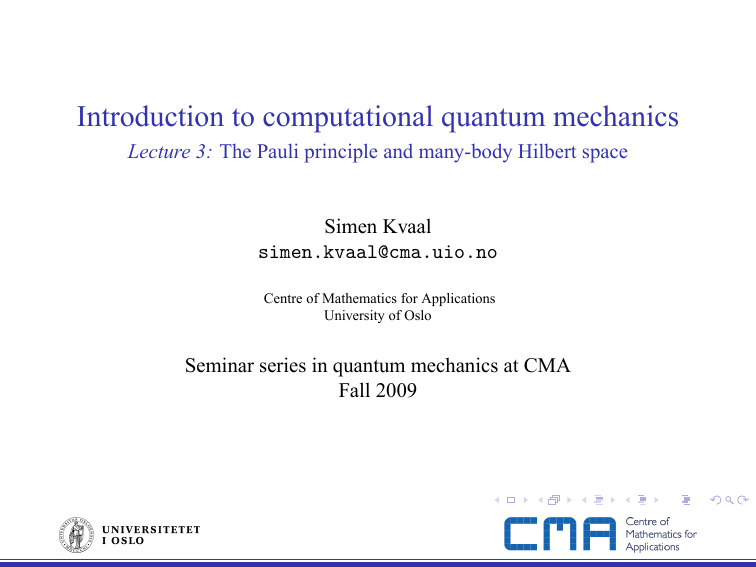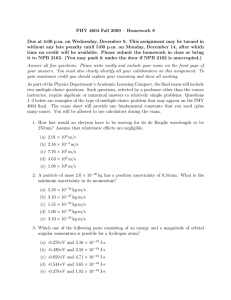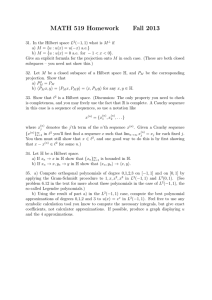Introduction to computational quantum mechanics Lecture 3: Simen Kvaal
advertisement

Introduction to computational quantum mechanics
Lecture 3: The Pauli principle and many-body Hilbert space
Simen Kvaal
simen.kvaal@cma.uio.no
Centre of Mathematics for Applications
University of Oslo
Seminar series in quantum mechanics at CMA
Fall 2009
Outline
Tensor product spaces
Configuration space and identical particles
Creation and annihilation operators and N-particle Hilbert space
References
Outline
Tensor product spaces
Configuration space and identical particles
Creation and annihilation operators and N-particle Hilbert space
References
A note on tensor products of Hilbert spaces
I
I
Let Hi , i = 1, 2 be Hilbert spaces, with bases {φi,n }n , i = 1, 2.
The space H1 ⊗ H2 is defined by
H1 ⊗ H2 = span φ1,n1 ⊗ φ2,n2 ∈ H1 × H2
I
Closure with respect to inner product:
h(ψ1 ⊗ ψ2 )|(φ1 ⊗ φ2 )i := hψ1 |φ1 i1 hψ2 |φ2 i2 .
I
Examples:
L2 (R2 ) = L2 (R) ⊗ L2 (R).
2
Cn = Cn ⊗ C n .
Example of tensor product space
I
I
The space L2 (0, 1) has an ONB {φn } where
√
φn (x) = 2 sin(nπx), n = 1, 2, . . . .
Forming the tensor products Φn1 ,n2 (x1 , x2 ) we get
Φn1 ,n2 (x1 , x2 ) = (φn1 ⊗ φn2 )(x1 , x2 ) = 2 sin(n1 πx1 ) sin(x2 πx2 ).
I
These Φn1 ,n2 form a basis for L2 (0, 1) ⊗ L2 (0, 1) = L2 ().
Vectors in product spaces
I
Expansion in product basis:
Ψ=
I
∑ cn1 ,n2 Φn1 ,n2
n1 ,n2
By constructing a bijective map I : N2 → N, we see that this is no
different than ordinary basis expansions.
Ψ = ∑ cI −1 (α) ΦI −1 (α) ,
α
I
α = I(n1 , n2 )
We typically abuse notation here and write cα = cn1 ,n2 etc, as there is
usually no danger of confusion. Example of a map I:
Outline
Tensor product spaces
Configuration space and identical particles
Creation and annihilation operators and N-particle Hilbert space
References
Configuration space
I
For a classical system, the
configuration space X is the
space of configurations, i.e.,
the set of possible positions x
for the system. A manifold.
I
The quantum mechanical Hilbert space for the quantum version of the
system is then
H = L2 (X)
I
In QM, X contains additional discrete degrees of freedom: for example
spin. This has no classical analogue.
Spin/discrete degrees of freedom
I
Consider a finite, dicrete set S:
S = {s1 , s2 , . . . , s|S| }
I
Consider the manifold
Y = X × S.
Adding discrete degrees of freedom
I
S is equipped with counting measure, so that
L2 (S) = C|S| .
I
The space L2 (X × S) becomes
L2 (X × S) = L2 (X) ⊗ C|S| ∼
= L2 (X)|S| .
I
Ψ is a function of x ∈ X and s ∈ S simultaneously:
Ψ = Ψ(x, s)
I
Ψs (x)
That is, Ψ ∈ L2 (X × S) is essentially |S| component functions
Ψs ∈ L2 (X), s ∈ S.
The inner product is
hΨ|Φi = ∑ hΨs |Φs i .
s
I
“Some degrees of freedom are continuous (which we integrate over),
and others are discrete (which we sum over)”.
Identical particles
I
I
I
I
Identical particles share all measurable physical characteristics: mass,
charge, spin . . .
In classical mechanics, the particles may be distinguished by attaching
a label to each corrdinate, i.e., ~xk . Since we can track each particle in
time, we can say “at time t, particle k was at ~xk (t)”.
Problem: This contradicts quantum mechanics. There is no way to
continuously measure the position of each particle in a quantum system.
Consequence: In quantum physics, indistinguishability is a fundamental
concept and profoundly alters the physical properties of a system.
Configuration space of identical particles
I
For N identical particles on a manifold X, the configuration space is
XN /SN
(also a manifold)
Figure: Illustration of identification of different permutations of points x1 , x2 and x3 .
In X3 (left), exchanging xi and xj leads to different points, while on X3 /S3 these
points are identified. The result is actually a manifold.
Hilbert space for identical particles
I
I
I
Working with L2 (XN /SN ) is cumbersome.
But: If dim(X) ≥ 3, the Hilbert space L2 (XN /SN ) contains two
components. Each is isomorphic to the symmetric and anti-symmetric
part of L2 (XN ), respectively. Note: L2 (XN ) = L2 (X)N .
Ψ(x1 , · · · , xN ) is called symmetric if for every σ ∈ SN
Pσ Ψ(x1 , · · · , xN ) := Ψ(xσ(1) , · · · , xσ(N) ) = Ψ(x1 , · · · , xN ).
I
Ψ(x1 , · · · , xN ) is called anti-symmetric if for every σ ∈ SN
Pσ Ψ(x1 , · · · , xN ) = sgn(σ)Ψ(x1 , · · · , xN ).
I
The (anti-)symmetric functions in L2 (XN ) constitute a closed subspace,
with projector Π+ (Π− ), and is thus a Hilbert space on its own.
Fermions and bosons
I
It seems to be a fundamental law of nature, that particles fall into one of
two categories:
bosons: Pσ Ψ = Ψ
fermions: Pσ Ψ = sgn(σ)Ψ
I
I
I
Thus, if we study fermions, we work with the anti-symmetric part of
L2 (XN ), while we use the symmetric part for bosons. (These have
projectors Π− and Π+ , respectively.)
Typical fermions are electrons, protons, neutrons. Typical bosons are
photons and composite particles (such as the hydrogen atom).
From now on, we work with fermions.
Example
I
We consider two fermions living on (0, 1), with S = {↑, ↓} being the
discrete set:
For one particle: X = (0, 1) × S
For two particles:
I
I
Hilbert space:
X2 = (0, 1)2 × S2
H = Π− L2 ( × S2 ).
The coordinate of particle k on the manifold X is ξk := (xk , sk ), so Ψ is
a function of ξ1 and ξ2 :
Ψ = Ψs1 ,s2 (x1 , x2 )
I
I
Antisymmetry:
Ψs2 ,s1 (x2 , x1 ) = −Ψs1 ,s2 (x1 , x2 ).
Inner product:
hΨ|Φi =
∑ hΨs1 ,s2 |Φs1 ,s2 i
s1 ,s2
(inner prod. on L2 ())
Outline
Tensor product spaces
Configuration space and identical particles
Creation and annihilation operators and N-particle Hilbert space
References
Ok, breathe and relax . . .
Forget all about configuration space and discrete degrees of freedom. Now
we’re gonna focus on the anti-symmetry thing and construct a basis for the
N-body Hilbert space.
Our starting point now is the fact that:
1. We are given an ONB for H1 = L2 (X) – i.e., one-particle Hilbert space
2. L2 (XN ) = L2 (X)N (not obvious, but true for spaces of interest, at least)
3. N-fermion Hilbert space is HN = Π− L2 (XN )
Our goal: Obtain a basis for HN for all N. This basis is the most important
thing in many applications.
Slater determinants
I
Given an orthonormal basis for H1 = L2 (X):
{φn : n = 1, 2, . . .}
I
I
H1N has then an orthonormal basis
Φn1 ,··· ,nN := φn1 ⊗ · · · ⊗ φnN
For any Ψ ∈ HN = Π− H1N , we have
Ψ = ∑ cn1 ,··· ,nN Φn1 ,··· ,nN .
~n
I
Ψ ∈ HN is antisymmetric, so for any σ ∈ SN :
Pσ Ψ = ∑ c~n Φσ(~n) = ∑ cσ−1 (~n) Φ~n = ∑ sgn(σ)c~n Φ~n
~n
I
~n
~n
Thus:
cσ(~n) = sgn(σ)c~n ,
∀σ ∈ SN
Slater determinants 2
I
I
In particular: If nj = nk for j 6= k, c~n = 0.
We note that we may write:
Ψ=
I
I
∑
∑
n1 <n2 <... σ∈SN
c~n sgn(σ)Φσ(~n) =:
The Slater determinants can be written:
φn (x1 ) · · ·
1
1 .
SD
Φ~n = √ ..
N! φnN (x1 ) · · ·
∑
n1 <n2 <···
√
N!c~n Φ~SD
n .
φn1 (xN ) ..
.
φn (xN )
N
They are orthonormal (easy to show) and constitute a basis for
HN = Π− H1N . Due to double (or N!) counting, we need
n1 < n2 < · · · < nN .
Pauli exclusion principle
We now have an interesting observation: The index ~n for the Slater
determinant basis is replaced by a subset of N integers, since permutations
are identified. This is a statement of the indistinguishability of the particles!
Particles are “disallowed to be in the same one-particle state φn ”.
Figure: The basis Φ~n for H1N is enumerated by ordered sets of N integers, while the
basis for HN is enumerated by unordered sets.
Creation and annihilation operators 1
I
From the fact:
Basis BN for HN ←→ subsets of N integers
I
we may consider constructing BN±1 from BN by adding/removing an
element to the set.
Moreover:
subsets of N integers ←→ int’s with N nonzero binary digits
I
Example:
~n = {3, 5, 8} ←→ α = · · · 00010010100b
I
So setting or clearing a bit nicely describes the basis mapping.
Creation and annihilation operators 2
I
I
I
I
I
For α ∈ N, define #α = number of nonzero bits in binary representation.
We may regard α as a subset of integers, with unions, intersections, . . .
SD
We may write Φ~SD
n or Φα with no danger of confusion.
By considering properties of determinants, we may construct BN+1 by
adding a row/column to all the N-particle Slater determinants.
This results in the definition of a creation operator c†n for each
n = 1, 2, . . .. This adds a row/column and reorders the determinant so
that n1 < n2 < . . .. Thus:
(
(−1)j ΦSD
/α
† SD
α∪{n} if n ∈
cn Φα =
0
if n ∈ α
The sign change comes from the reordering needed to obtain a Slater
determinant with ordered indices.
By linear extension, c†n is a linear operator that maps BN onto BN+1 .
Creation and annihilation operators 3
I
I
I
I
For all n, c†n : HN → HN+1 is bounded with norm 1. (Obviously!)
The adjoint cn : HN+1 → HN is called an annihilation operator.
The dagger notation is standard in physics, so we adopt it.
Fact:
{cn , cm } = 0,
I
{cn , c†m } = δn,m 1,
where {A, B} := AB + BA
By defining H0 as some (arbitrary) one-dimensional space with basis
vector (“the vacuum”) ΦSD
0 , we have:
† †
†
SD
ΦSD
n1 ,n2 ,··· ,nN = cn1 cn2 · · · cnN Φ0 ,
I
n1 < n2 < · · · ,
i.e., all Slater determinants can be generated from vacuum using
creation operators.
This is actually a quite vivid and natural description of the underlying
mathematics.
Fock space
I
For any Ψ ∈ HN :
Ψ=
∑
α, #α=N
cα ΦSD
α .
Or, equivalently:
HN =
Span(ΦSD
α ) (closure implied).
M
α, #α=N
I
Fock space can be defined as:
H˜ =
∞
M
N=0
HN =
M
α
Span(ΦSD
α ),
i.e., all Slater determinants with varying number of particles naturally
define one big mother of a QM Hilbert space.
A hint at the usefulness
I
I
I
Often, questions depend on the number of particles present, and we
have seen that the Hilbert space has a very complicated structure for
many particles.
On the other hand, we have seen that from a basis for, e.g., L2 (R3 ), or
some approximation such as finite element spaces, the corresponding
N-body space can “easily” be manipulated using creation and
annihilation operators. Implementations can be done using clever
bit-pattern manipulations already hinted at.
Moreover, we shall see later that even the Hamiltonian has a simple
form for arbitrary number of particles using c†n and cn .
Outline
Tensor product spaces
Configuration space and identical particles
Creation and annihilation operators and N-particle Hilbert space
References
References
Raimes, S.
Meny-Electron Theory
North-Holland
1972
Leinaas, J.M. and Myrheim, J.
Theory of Identical Particles
Nuovo Cimento 37, pp. 1–23
1977
Frankel, T.
The Geometry of Physics
Cambridge
2004







